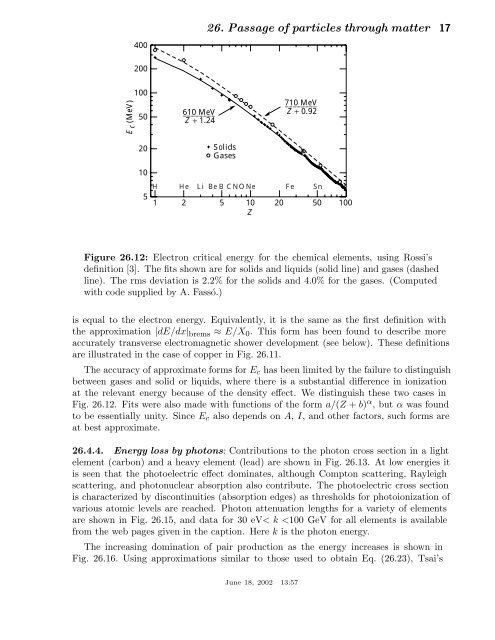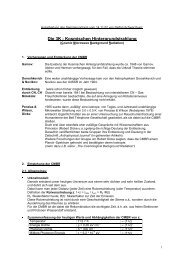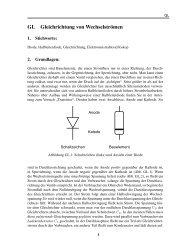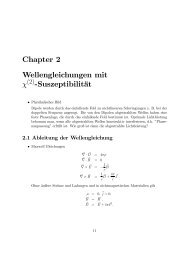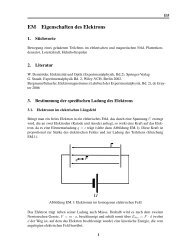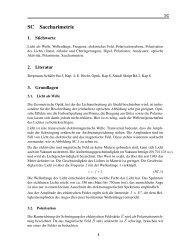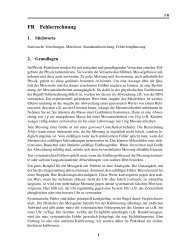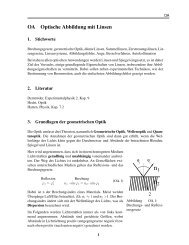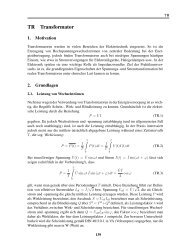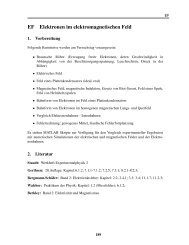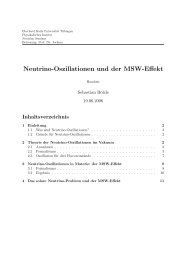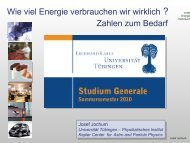26. passage of particles through matter - Particle Data Group
26. passage of particles through matter - Particle Data Group
26. passage of particles through matter - Particle Data Group
You also want an ePaper? Increase the reach of your titles
YUMPU automatically turns print PDFs into web optimized ePapers that Google loves.
<strong>26.</strong> Passage <strong>of</strong> <strong>particles</strong> <strong>through</strong> <strong>matter</strong> 17<br />
400<br />
200<br />
E c (MeV)<br />
100<br />
50<br />
610 ________ MeV<br />
Z + 1.24<br />
710 MeV ________<br />
Z + 0.92<br />
20<br />
Solids<br />
Gases<br />
10<br />
5<br />
H He Li Be B CNONe Fe Sn<br />
1 2 5 10 20 50 100<br />
Z<br />
Figure <strong>26.</strong>12: Electron critical energy for the chemical elements, using Rossi’s<br />
definition [3]. The fits shown are for solids and liquids (solid line) and gases (dashed<br />
line). The rms deviation is 2.2% for the solids and 4.0% for the gases. (Computed<br />
with code supplied by A. Fassó.)<br />
is equal to the electron energy. Equivalently, it is the same as the first definition with<br />
the approximation |dE/dx| brems ≈ E/X 0 . This form has been found to describe more<br />
accurately transverse electromagnetic shower development (see below). These definitions<br />
are illustrated in the case <strong>of</strong> copper in Fig. <strong>26.</strong>11.<br />
The accuracy <strong>of</strong> approximate forms for E c has been limited by the failure to distinguish<br />
between gases and solid or liquids, where there is a substantial difference in ionization<br />
at the relevant energy because <strong>of</strong> the density effect. We distinguish these two cases in<br />
Fig. <strong>26.</strong>12. Fits were also made with functions <strong>of</strong> the form a/(Z + b) α , but α was found<br />
to be essentially unity. Since E c also depends on A, I, and other factors, such forms are<br />
at best approximate.<br />
<strong>26.</strong>4.4. Energy loss by photons: Contributions to the photon cross section in a light<br />
element (carbon) and a heavy element (lead) are shown in Fig. <strong>26.</strong>13. At low energies it<br />
is seen that the photoelectric effect dominates, although Compton scattering, Rayleigh<br />
scattering, and photonuclear absorption also contribute. The photoelectric cross section<br />
is characterized by discontinuities (absorption edges) as thresholds for photoionization <strong>of</strong><br />
various atomic levels are reached. Photon attenuation lengths for a variety <strong>of</strong> elements<br />
are shown in Fig. <strong>26.</strong>15, and data for 30 eV< k


